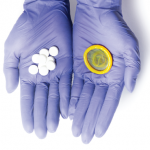Physicians caring for women with systemic lupus erythematosus (SLE) often face difficult decisions regarding the use of exogenous estrogens as part of the overall management plan. In certain circumstances the discussion is moot because a patient may have an unambiguous contraindication to estrogen therapy such as a thrombotic diathesis. In other cases, physician and patient must have a lengthy discussion, attempting to balance evidence for and against use. Three recently published randomized controlled trials offer new evidence to aid this discussion.
Strong Evidence from Recent Trials
The Safety of Estrogens in Lupus Erythematosus National Assessment (SELENA) trial comprised two separate studies. (I was the principal investigator on both in partnership with Dr. Michelle Petri.) One study focused on oral contraceptives (OCs) and the other on postmenopausal hormone replacement therapy (HRT).1,2 Both studies were designed as non-inferiority trials to establish that exogenous estrogens were not more likely than placebo to increase the risk of a severe flare.
The rationale for choosing severe flare and not all flares as an endpoint is that for many women a mild flare (e.g., an increase in arthralgias readily treated with over-the-counter nonsteroidal medications) might be an acceptable tradeoff for use of an effective and easy form of birth control. However, because the trial involved a drug that might increase the risk of flare, vigilance with regard to safety mandated that all flares be captured, even those that were extremely mild. Importantly, my colleagues and I excluded patients with a thrombophilic risk, defined specifically as:
- History of deep venous thrombosis, arterial thrombosis, or pulmonary embolus;
- Presence of IgG, IgM, or IgA anticardiolipin antibodies (GPL >40, MPL >40, or APL >50) and/or demonstration of lupus anticoagulant by dilute Russell viper venom time test (dRVVT); and
- History of myocardial infarction.
An important caveat regarding both trials is that patients’ lupus had to be inactive or stable-active for two months prior to randomization.
At first glance, the entry criteria for the trials might suggest that the results would be generalizable only to patients with relatively mild lupus (i.e., without organ-threatening disease). In fact, this was not the case, because approximately 40% of the patients in both trials had a history of lupus nephritis. Many patients had significantly active lupus in the past. While results obtained in the OC trial might not be applicable for the patient with active nephritis about to receive immunosuppressive agents, that same patient, when stabilized for several months, could then have become eligible. The presence of anti-dsDNA antibodies and low levels of complement in nearly a third of the patients again indicated that the results would likely be applicable to the patients seen in the “real world” of lupus.
The results of three large prospective trials indicate that there is generally excellent tolerance of exogenous hormones with regard to disease activity.
Study Specifics and Findings
For the SELENA-OC trial, 183 SLE patients were enrolled between June 1997 and July 2002 (with follow-up through July 2003) at 15 U.S. sites. To eliminate bias toward patients who would be likely to do well on OCs, patients were excluded if they had used OCs for more than one month after being diagnosed with SLE. Patients were randomized double-blind to OCs (triphasic 35 µg ethinylestradiol plus 0.5 to 1 mg norethindrone for twelve 28-day cycles) (N=91), or placebo (N=92) and evaluated at months 1, 2, 3, 6, 9, and 12. Thirty-seven percent were Caucasian, 33% African American, 16% Hispanic, and 14% Asian. As detailed in Table 1, the primary endpoint—severe flare—was rare: seven of the 91 patients on OCs (7.7%) versus seven of the 92 patients on placebo (7.6%). The 12-month severe flare rate was 0.084 for OCs and 0.087 for placebo, a difference of -0.0028 (P=0.95). (See Figure 1) The upper limit of the one-sided 95% confidence interval (CI) for this difference was 0.069, within the pre-specified 9% non-inferiority margin. Mild/moderate flare rates were similar: 1.40 versus 1.44 flares/person-years (OCs versus placebo), risk ratio (RR)=0.98, P=0.86.


